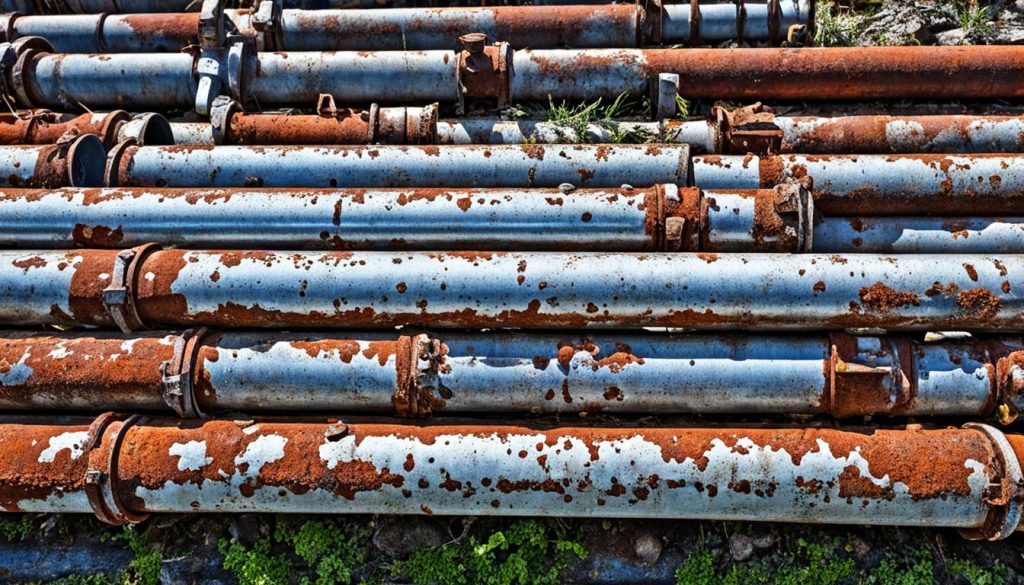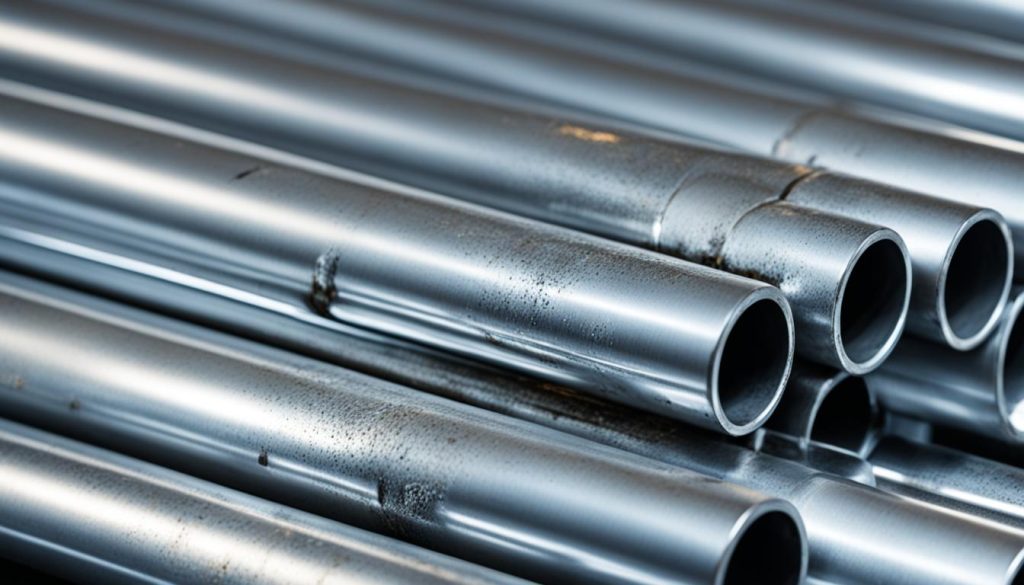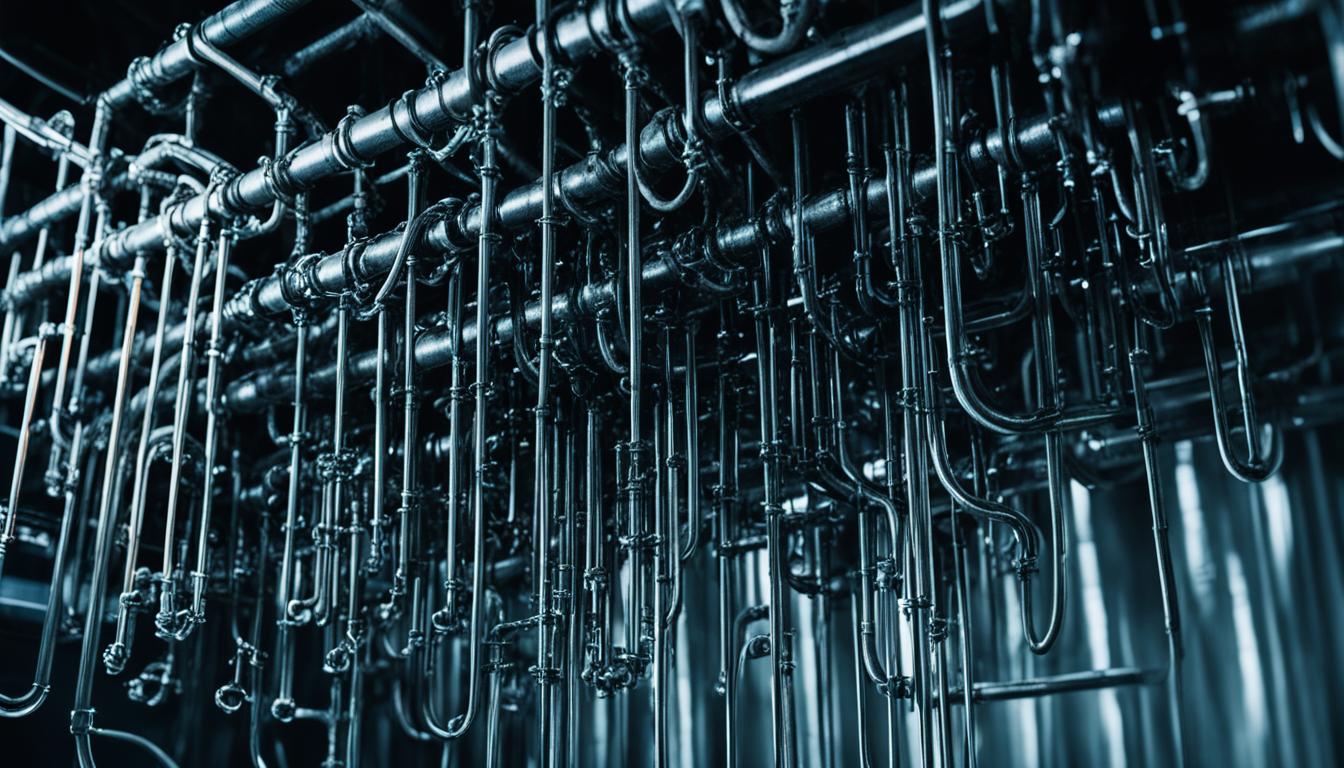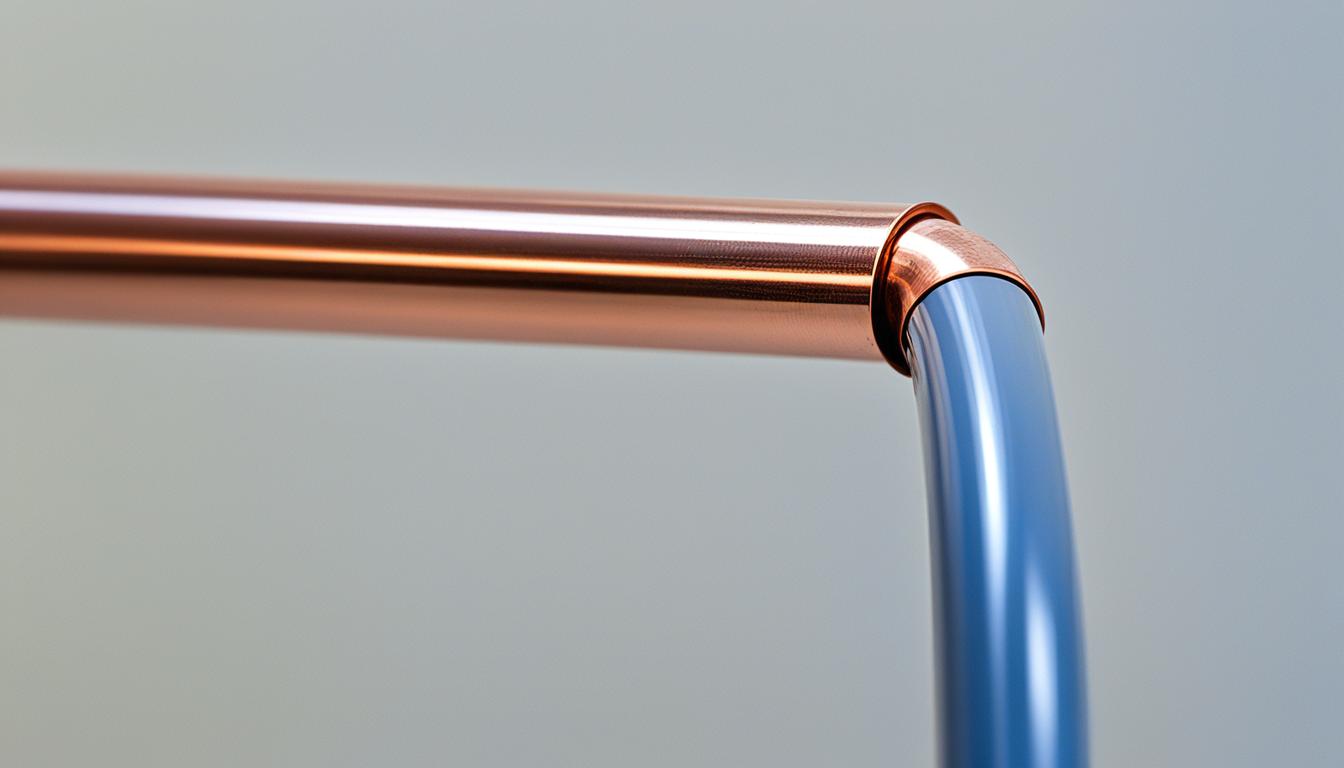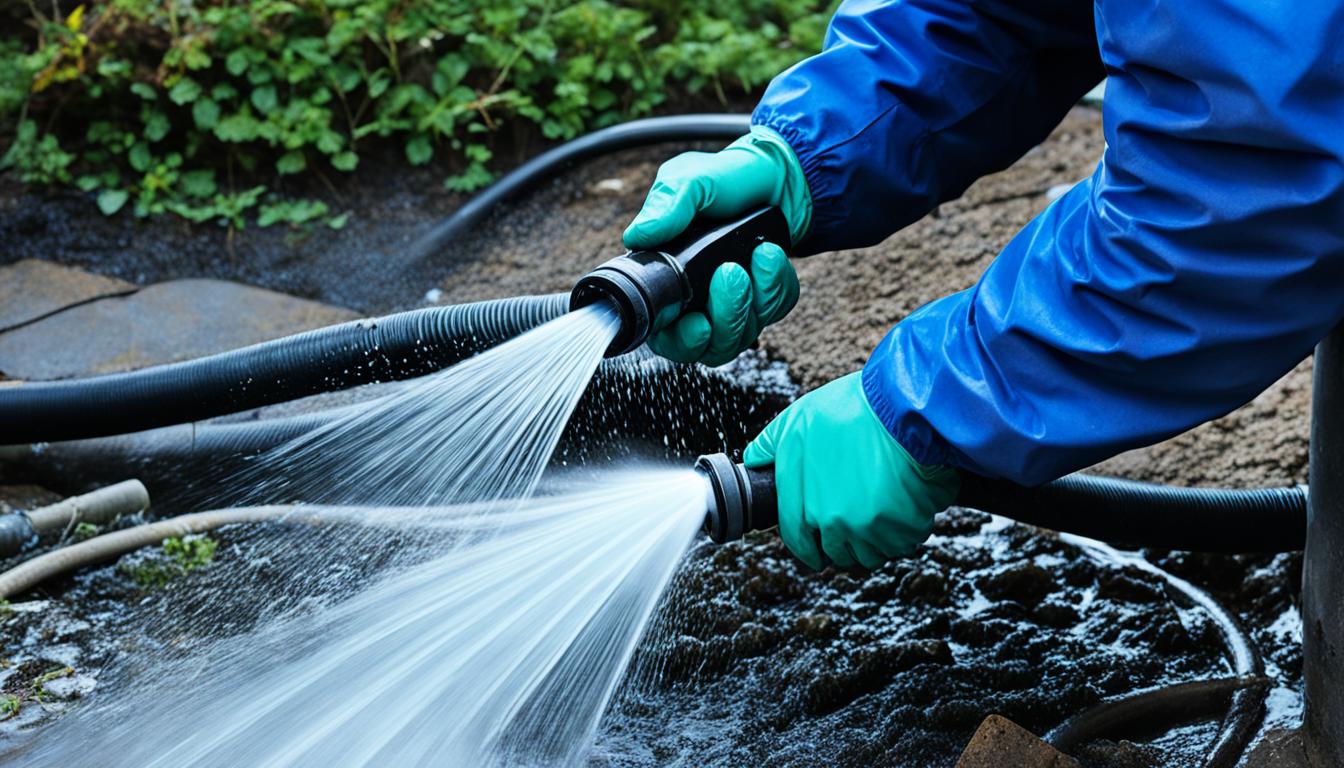Galvanized Pipe: Your Durable Piping Solution
Did you know that galvanized pipes were commonly used in homes built before the 1960s as a solution to lead piping? These steel pipes were dipped in a protective zinc coating to prevent corrosion and rust. However, over time, the galvanized/zinc coating diminishes, leading to potential health concerns, leaks, water discoloration, and low water pressure. Replacing galvanized pipes with modern materials like copper, PEX, or plastic PVC pipes is crucial for ensuring safer drinking water and preventing property damage.
Key Takeaways:
- Galvanized pipes were commonly used in homes built before the 1960s as a replacement for lead piping.
- Over time, the zinc coating on galvanized pipes diminishes, leading to corrosion and rust.
- Corroded galvanized pipes can pose health risks, including lead contamination in the drinking water.
- Replacing galvanized pipes with modern materials like copper, PEX, or plastic PVC pipes is recommended for safer and more reliable plumbing.
- The cost of replacing galvanized pipes can range from $2,000 to $15,000, depending on various factors such as the type of pipe, amount of piping needed, and the size of the home.
What Are Galvanized Pipes?
Galvanized pipes are steel pipes that have undergone a process called galvanizing, wherein they are dipped in a protective zinc coating. This coating serves as a barrier against corrosion and rust, making the pipes more durable and long-lasting. Galvanized pipes were initially introduced as a safer alternative to lead piping, which posed significant health risks due to lead poisoning.
The galvanizing process involves immersing the steel pipes in molten zinc, creating a chemical bond that prevents the formation of rust and corrosion. The zinc coating provides an extra layer of protection, especially for pipes that are exposed to harsh environmental conditions or corrosive substances.
While galvanized pipes are known for their durability, over time, the zinc coating gradually degrades, leaving the pipes susceptible to corrosion. This corrosion can lead to various issues, including leaks, water discoloration, and potentially even health concerns if the corroded pipes contaminate the drinking water.
To better understand the process of galvanizing, let’s take a look at the following table:
| Process | Advantages | Disadvantages |
|---|---|---|
| Galvanizing | – Provides excellent corrosion resistance – Durable and long-lasting – Relatively low-cost – Easy installation |
– Gradual degradation of zinc coating – Potential health concerns if corrosion sets in – May require replacement after several decades |
Why Are Galvanized Pipes a Problem?
Corrosion is the main issue with galvanized pipes. As the zinc coating diminishes, pipes can become corroded, both on the inside and outside.
Corroded pipes can collect small deposits of lead particles, which can contaminate the drinking water. This poses health concerns, especially for children, who may experience lead poisoning symptoms.
Corroded pipes can also cause leaks, low water pressure, and water discoloration. These issues can increase the likelihood of a damaging leak, leading to potential property damage and increased insurance rates.
To give you a better understanding, let’s take a closer look at the consequences of corroded pipes:
Lead Contamination
Corroded galvanized pipes have the potential to collect small deposits of lead particles, which can seep into the drinking water supply. Lead contamination is a serious health concern, as it can lead to various health problems, including developmental delays, learning difficulties, and behavioral issues in children.
Leaks and Water Pressure
Corroded pipes are more prone to developing leaks, which can result in water damage to your property. These leaks can occur both inside your home, causing structural damage to walls and floors, and outside, leading to damage in your yard or foundation.
In addition, corroded pipes can cause low water pressure throughout your plumbing system. This can make simple tasks like showering or washing dishes frustrating and time-consuming.
Water Discoloration
Another common issue with corroded galvanized pipes is water discoloration. If you notice brown, reddish, or yellowish water coming out of your faucets, it may be a sign that your pipes are corroded. This discoloration is caused by the flaking of the zinc coating, which can mix with the water and result in unpleasant colors.
| Consequences of Corroded Galvanized Pipes |
|---|
| Lead contamination |
| Leaks and water damage |
| Low water pressure |
| Water discoloration |
In summary, corroded galvanized pipes pose significant health concerns, property damage risks, and potential increases in insurance rates due to the likelihood of a damaging leak. It is important to address the issue promptly by replacing galvanized pipes with modern materials to ensure the safety and integrity of your plumbing system.
How Can I Determine if I Have Galvanized Pipes?
If you’re unsure whether your home has galvanized pipes, there are a couple of methods you can use to find out. One option is to hire a professional home inspector who can assess and identify the type of pipes in your home. They have the expertise and knowledge to accurately determine if you have galvanized pipes or not.
Another method is to perform a simple scratch test yourself. Here’s how you can do it:
- Locate the pipes that you suspect might be galvanized.
- Using a coin or a sharp object, lightly scratch the surface of the pipe.
- Observe the color of the pipe revealed by the scratch.
If the pipes appear silver or grey metal with threads, they are likely galvanized steel pipes. On the other hand, if the pipes have a different color, such as copper or plastic PVC pipes, then they are not galvanized.
It’s important to note that while the scratch test can give you a rough indication, it’s always recommended to consult a professional to accurately assess the type of pipes in your home. They can provide a comprehensive analysis and guide you in the right direction for any necessary repairs or replacements.
Potential Risks and Replacement Options
Galvanized pipes can pose significant risks, including lead contamination and compromised water supply. To ensure the safety of your drinking water and the overall integrity of your plumbing system, it is highly recommended to replace galvanized pipes with modern alternatives. There are several replacement options available, each with its own advantages and considerations:
Copper Pipes
Copper pipes are a popular replacement option for galvanized pipes. They have a life expectancy of 20-50 years and offer excellent corrosion resistance. Copper pipes are also safe for drinking water and do not release harmful substances that could contaminate the water supply. Additionally, copper pipes are flexible, making them easy to install and resistant to leaks.
PEX (Cross-Linked Polyethylene) Pipes
PEX pipes are another viable option for replacing galvanized pipes. Made of cross-linked polyethylene, PEX pipes have a lifespan of 40-50 years. They are highly durable, resistant to corrosion, and can withstand extreme temperatures, making them suitable for both hot and cold water supply systems. PEX pipes are also flexible, allowing for easy installation and minimizing the risk of leaks.
Plastic PVC Pipes
Plastic PVC pipes are a cost-effective replacement for galvanized pipes. With a lifespan of 25-40 years, plastic PVC pipes offer good resistance to corrosion and provide a reliable water supply. They are lightweight, making them easy to handle during installation, and have excellent chemical resistance. Plastic PVC pipes are commonly used for water supply and drainage systems.
When choosing a replacement option for galvanized pipes, consider factors such as your budget, specific plumbing needs, and the longevity you desire for your plumbing system. Consulting a professional plumber can help you make an informed decision based on your unique circumstances.
| Replacement Option | Life Expectancy | Advantages |
|---|---|---|
| Copper Pipes | 20-50 years | Excellent corrosion resistance, safe for drinking water, flexible |
| PEX Pipes | 40-50 years | Durable, resistant to corrosion and extreme temperatures, flexible |
| Plastic PVC Pipes | 25-40 years | Cost-effective, resistant to corrosion and chemicals, lightweight |
The Cost of Replacing Galvanized Pipes
When it comes to replacing galvanized pipes, the cost can vary depending on several factors. Factors such as the type of pipe chosen for replacement, such as copper pipes, PVC pipes, or PEX pipes, will have an impact on the overall cost. Additionally, the amount of piping that needs to be replaced, the size of the home, and the location and experience of the plumber can all affect the final price.
In general, homeowners can expect to pay between $2,000 and $15,000 for the replacement of galvanized pipes. While this may initially seem like a significant investment, it is important to consider the long-term benefits. Replacing galvanized pipes with modern materials ensures a safer and more reliable plumbing system.
By investing in the replacement of galvanized pipes, homeowners can avoid potential issues such as leaks, water discoloration, and low water pressure. This helps prevent costly repairs and property damage in the future. Moreover, it promotes water safety and provides peace of mind knowing that the plumbing system is secure and efficient.
Cost Comparison of Galvanized Pipe Replacement Options
| Pipe Material | Cost Range | Approximate Lifespan |
|---|---|---|
| Copper Pipes | $5,000 – $15,000 | 20-50 years |
| PVC Pipes | $2,000 – $6,000 | 25-40 years |
| PEX Pipes | $3,000 – $10,000 | 40-50 years |
The table above provides a cost comparison of different pipe replacement options. Copper pipes, although more expensive, have a longer lifespan and are known for their durability. PVC pipes and PEX pipes offer more affordable alternatives, with varying lifespan expectations. It is important to consider your budget and specific plumbing needs when choosing the replacement material.
While the cost of replacing galvanized pipes may be an investment, it is essential for ensuring the long-term reliability and safety of your plumbing system. By choosing the right material and hiring a reputable plumber, you can enjoy the benefits of a modern and efficient plumbing system while avoiding potential issues and costly repairs in the future.
The Importance of Replacing Galvanized Pipes
Replacing galvanized pipes is crucial for maintaining water safety and preventing potential property damage. Galvanized pipes, while once considered a durable solution, can pose health risks due to lead contamination and compromised water supply. Corroded galvanized pipes often result in leaks, low water pressure, and water discoloration, compromising the overall integrity of the plumbing system.
By replacing galvanized pipes with modern materials like copper, PEX, or plastic PVC, homeowners can ensure safer drinking water and mitigate the risk of costly leaks. These modern materials provide superior durability and longevity, offering peace of mind for homeowners. Furthermore, investing in the replacement of galvanized pipes can potentially save homeowners from headaches, costly property damage, and potential health concerns in the future.
Making the switch to modern materials not only improves water safety but also enhances the overall efficiency and reliability of the plumbing system. With modern pipes, homeowners can enjoy improved water flow, reduced maintenance needs, and increased resistance to corrosion. By prioritizing the replacement of galvanized pipes, homeowners can proactively protect their property and the well-being of their family.
Source Links
- https://www.detroitnippleworks.com/reasons-to-choose-galvanized-steel-pipe/
- https://www.whittinspections.com/homeowner-resources/galvanized-pipes/
- https://americanvintagehome.com/blog/need-swap-galvanized-pipes/
- Investing Wisely: How Windows & Doors in Boost Property Value and Financial Health - April 24, 2025
- The Financial Impact of Personal Injuries: Why Legal Help Matters for Business Owners - April 16, 2025
- The Hidden Financial Costs of Domestic Assault: What Business Owners Need to Know - April 16, 2025
